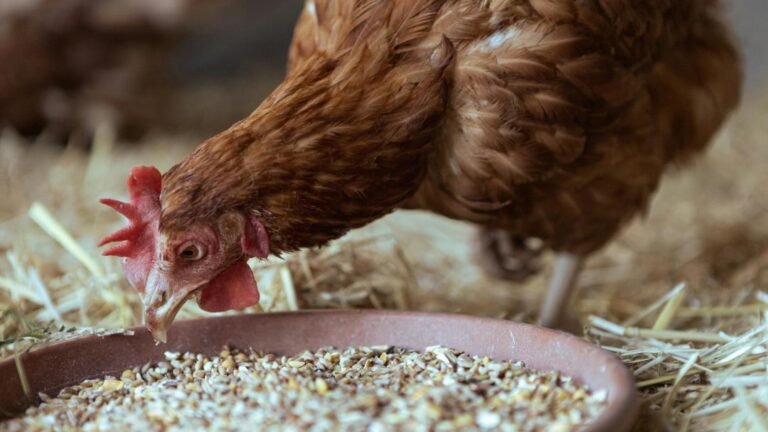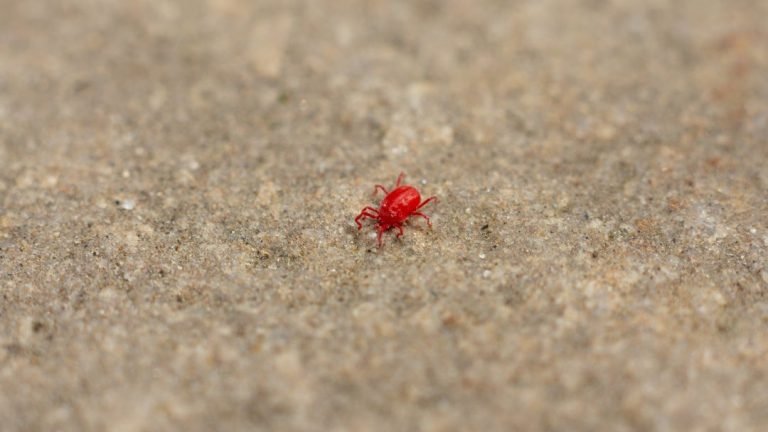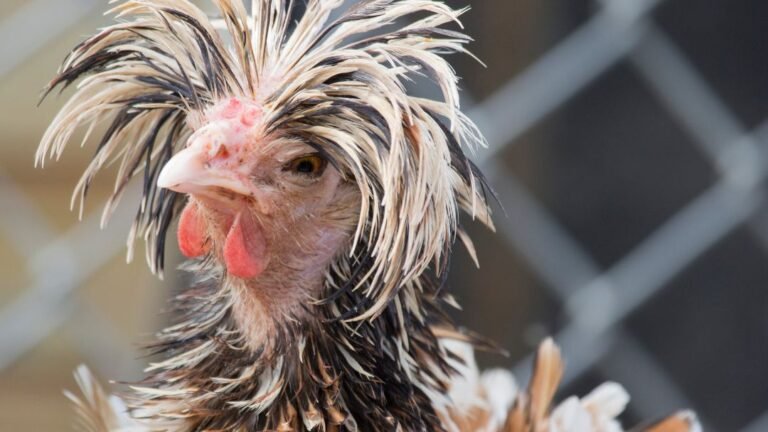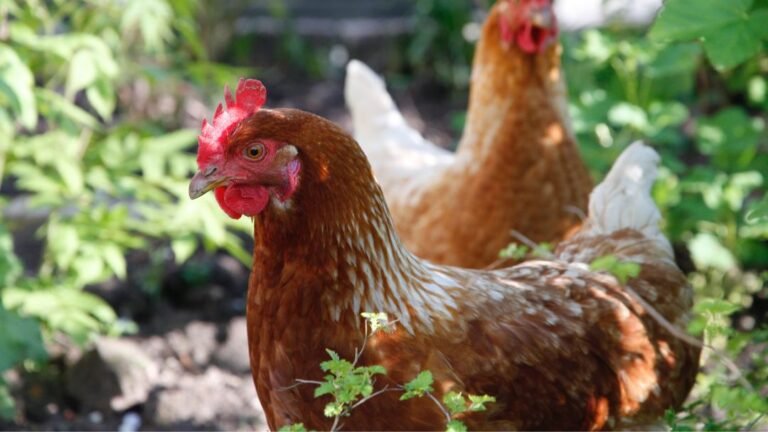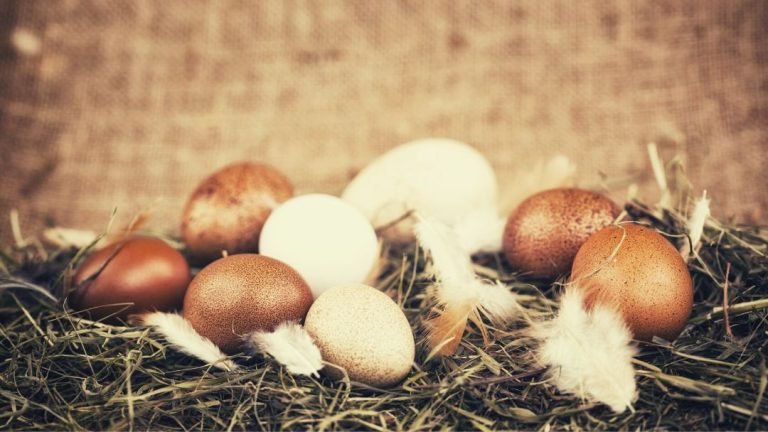The best bedding for a chicken coop is straw or wood shavings. These materials provide comfort and absorb moisture effectively, keeping the coop clean and preventing bacterial growth.
When choosing bedding for your chicken coop, it is important to consider the needs of the chickens and the ease of cleaning. Straw and wood shavings are popular choices as they provide a comfortable surface for the chickens to walk on and nest in.
These materials also absorb moisture well, which helps to maintain a clean and dry environment. Additionally, straw and shavings are relatively easy to clean out of the coop, making them a practical option for chicken owners. By selecting the right bedding, you can ensure the health and well-being of your feathered friends.
Providing Comfort And Warmth For Healthy Chickens
Bedding Materials Play A Crucial Role In Maintaining A Cozy And Clean Environment For Chickens.
When it comes to creating the perfect living space for your feathered friends, providing comfort and warmth is essential. One way to achieve this is by choosing the right bedding materials for their coop. Beddings not only help create a comfortable atmosphere, but they also play a crucial role in maintaining hygiene and managing odor. Let’s explore some of the best bedding materials that can keep your chickens happy and healthy.
Adequate Bedding Helps Regulate Temperature And Provides Insulation, Keeping Chickens Warm In Colder Months.
Nothing feels better than snuggling up in a warm and cozy bed on a cold winter night. Well, the same goes for chickens! Adequate bedding serves as a natural insulator, helping them combat the chill of colder months. By providing an extra layer of warmth, bedding materials like straw, hay, or wood shavings help chickens maintain their body temperature even when the weather outside is frigid. In addition to warmth, these materials also provide insulation, preventing drafts from reaching the birds. This added layer of protection keeps them cozy, reducing the risk of illnesses caused by extreme temperature fluctuations.
Comfortable Bedding Also Promotes Healthier Feather Growth And Reduces The Risk Of Foot And Leg Problems.
Chickens with healthy feathers not only look beautiful, but those feathers also serve as excellent insulation. Soft and comfortable bedding materials contribute to proper feather development by reducing stress and preventing feather loss. When chickens have a comfortable place to rest and sleep, it allows their feathers to grow more efficiently, resulting in healthier and more vibrant plumage. Moreover, the right bedding options also reduce the risk of foot and leg problems in chickens. Materials like straw and wood shavings provide a cushioning effect, ensuring that their delicate feet and legs are protected from direct contact with hard surfaces. This helps prevent injuries and promotes strong and well-developed legs in your feathered friends.
Providing a cozy and warm environment for your chickens is vital for their overall well-being. Proper bedding not only maintains a clean and odor-free coop but also ensures that your feathered flock stays comfortable and healthy throughout the year.
Factors To Consider When Choosing Bedding
Absorbency: Opt For Bedding That Efficiently Absorbs Moisture, Keeping The Coop Dry And Odor-free.
When it comes to selecting bedding for your chicken coop, one crucial factor to consider is its absorbency. Choosing bedding that efficiently absorbs moisture is vital in keeping the coop dry and odor-free. This is particularly important as excessive moisture can lead to health issues for your chickens and create an unpleasant living environment.
To ensure optimal absorbency, go for bedding materials that have high moisture-wicking capabilities. Popular options such as straw, wood shavings, and pine pellets are known for their excellent absorbency. These materials not only soak up moisture effectively but also help maintain a hygienic coop by reducing the growth of bacteria and fungi.
Dustiness: Choose Bedding With Low Dust Content To Prevent Respiratory Issues In Chickens.
Another essential factor to consider when selecting bedding for your chicken coop is its dust content. Dustiness in bedding can pose a significant risk to your chickens’ respiratory health. Excess dust particles in the air can irritate their lungs, leading to respiratory issues, allergies, and discomfort.
To prevent these problems, opt for bedding materials with low dust content. Wood shavings, straw, and hemp bedding are commonly recommended choices due to their limited dustiness. These materials provide a safer and more comfortable environment for your feathered friends, reducing the risk of respiratory ailments.
Availability: Consider The Accessibility And Availability Of Bedding Materials In Your Area.
When choosing bedding for your chicken coop, it’s crucial to take into account the availability of different materials in your area. Some bedding options may be more readily accessible and affordable, depending on your location.
Consider local resources and suppliers to ensure a consistent and convenient supply of bedding. It’s wise to choose materials that are readily available to avoid disruptions in maintaining a clean and comfortable coop for your chickens. This is particularly important if you have a large flock or limited storage capacity for bulk bedding.
Cost-effectiveness: Evaluate The Cost Of Various Bedding Options And Their Lifespan.
Cost-effectiveness is a crucial aspect to ponder when selecting bedding for your chicken coop. Evaluating the cost of different bedding options and comparing their lifespan can help you make an informed decision.
| Bedding Option | Cost | Lifespan |
|---|---|---|
| Straw | Low | Short |
| Wood Shavings | Moderate | Medium |
| Pine Pellets | Moderate | Long |
| Hemp Bedding | High | Longest |
As shown in the comparison table, bedding options have varying costs and lifespans. While straw may be the cheapest option, it needs frequent replacement due to its short lifespan. Wood shavings and pine pellets are moderately priced and offer a longer lifespan. Hemp bedding, although relatively more expensive, is highly durable and can last the longest.
Consider your budget and the long-term benefits of each bedding option to determine the most cost-effective choice for your chicken coop.
Straw
Straw is a popular and cost-effective bedding option for chicken coops. It offers several benefits that make it a suitable choice. Let’s take a closer look at why straw is commonly used as chicken coop bedding.
Straw Is A Common And Affordable Bedding Option For Chicken Coops.
Straw is readily available and can be easily obtained from agricultural suppliers. Its affordability makes it a go-to choice for many chicken keepers. Additionally, straw is lightweight and easy to handle, making it convenient to spread across the coop floor.
It Provides Good Insulation And Absorbs Moisture Well.
Straw acts as a natural insulator, helping to regulate the temperature inside the chicken coop. It provides a layer of protection against cold drafts during the winter and helps keep the coop cool in hot weather. Furthermore, straw has excellent moisture-absorbing properties, which are crucial for maintaining a dry and comfortable environment for the chickens.
However, Straw May Harbor Mites And Mold If Not Replaced Regularly.
One important consideration when using straw as bedding is that it requires regular replacement. Failure to do so can lead to the accumulation of mites and mold, which can be harmful to the chickens’ health. Therefore, diligent coop maintenance is necessary to prevent these issues. By replacing the straw bedding periodically and keeping the coop clean, you can minimize the risk of mites and mold infestation.
In conclusion, straw serves as an affordable and effective bedding option for chicken coops. Its insulation and moisture-absorbing properties contribute to creating a comfortable environment for the chickens. However, it is essential to replace the straw regularly to avoid potential issues with mites and mold.
Wood Shavings
Wood shavings, such as pine or cedar, are widely used for chicken coop bedding. They offer excellent absorbency and help control odors. When it comes to choosing the best bedding for your chicken coop, wood shavings are a popular choice due to their many benefits.
Pine Or Cedar Shavings
When selecting wood shavings for your chicken coop, pine and cedar are the two common options. Both types of shavings have their advantages and considerations.
Pine Shavings
Pine shavings are:
- Available in most pet and farm supply stores.
- Relatively inexpensive compared to other bedding options.
- Known for their high absorbency, which helps keep the coop clean and dry.
- Effective in controlling odors, ensuring a healthier environment for your chickens.
It is important to note that pine shavings are especially suitable for most chicken breeds.
Cedar Shavings
Cedar shavings come with their own set of considerations:
- Offer similar absorbency and odor control properties as pine shavings.
- Known for their natural freshness and aromatic scent.
- However, if you have respiratory-sensitive chickens, it is best to avoid cedar shavings. The aromatic oils in cedar can cause respiratory irritation in certain individuals.
Therefore, when choosing between pine and cedar shavings, take into account the specific needs and sensitivities of your flock.
Irrespective of the wood shaving type you choose, ensure you:
- Keep the coop clean and dry by regularly removing soiled bedding.
- Provide a thick layer of shavings, as a thin layer may not effectively control odors.
- Monitor the bedding regularly for signs of mold or insects, and replace as needed.
In conclusion, wood shavings, such as pine or cedar, make excellent bedding options for chicken coops. Both types offer great absorbency and help control odors, ensuring a healthier and more comfortable environment for your chickens. Just remember to consider any respiratory sensitivities your flock may have and choose accordingly.
Hemp Bedding
Hemp Bedding Is An Eco-friendly And Highly Absorbent Option
If you’re looking for an eco-friendly and highly absorbent bedding option for your chicken coop, hemp bedding is a fantastic choice. Hemp is a sustainable and renewable resource that offers numerous benefits for both you and your feathered friends.
Hemp bedding is made from the stalks of the hemp plant, which are processed into a soft and fluffy material that provides excellent comfort for your chickens. Unlike other bedding options, hemp bedding is biodegradable and doesn’t contain any harmful chemicals or additives.
One of the major advantages of hemp bedding is its exceptional absorbency. Hemp fibers have a natural ability to absorb moisture, making them ideal for keeping the coop clean and dry. This feature not only ensures the well-being of your chickens but also makes cleaning and maintenance a breeze.
By using hemp bedding, you can effectively reduce the moisture levels in the coop, minimizing the chances of bacterial growth and potential health issues for your flock. The absorbent properties of hemp also help in controlling unpleasant odors, keeping the coop smelling fresh and clean.
Hemp Bedding Has Natural Antibacterial Properties And Controls Odors Effectively
In addition to its absorbent qualities, hemp bedding offers natural antibacterial properties that contribute to a healthier coop environment. The inherent antimicrobial characteristics of hemp fibers help prevent the growth and spread of harmful bacteria, fungi, and mites.
This is particularly beneficial for your chickens’ respiratory health, as it helps reduce the risk of respiratory infections and other ailments. By using hemp bedding, you are creating a clean and hygienic space for your flock to thrive.
Furthermore, hemp bedding effectively controls odors in the coop. Its natural ability to absorb and lock in moisture ensures that ammonia and other unpleasant smells don’t accumulate. When using hemp bedding, you’ll notice a significant reduction in odor, creating a more enjoyable environment for both you and your chickens.
Hemp Bedding Is More Expensive Compared To Other Options
While hemp bedding offers a multitude of benefits, it is important to note that it is generally more expensive compared to other bedding options available for chicken coops. The higher price is primarily due to the cost involved in growing and processing hemp plants into bedding material.
However, the long-term advantages of using hemp bedding often outweigh the initial cost. With its superior absorbency, antibacterial properties, and odor control capabilities, hemp bedding can lead to a healthier and cleaner coop, which can contribute to overall improved flock health and productivity.
When considering your options, it’s essential to weigh the long-term benefits and cost-effectiveness of hemp bedding against other available alternatives. Ultimately, the decision comes down to your budget, personal preferences, and the well-being of your beloved chickens.
Sand
Sand Is Becoming Increasingly Popular For Chicken Coop Bedding
When it comes to choosing bedding for your chicken coop, sand is gaining popularity among chicken owners. Sand has several advantages that make it an excellent choice for keeping your chickens comfortable and maintaining a clean and odor-free coop.
It Provides Excellent Drainage And Reduces Odor
One of the main benefits of using sand as bedding is its excellent drainage properties. Sand allows any liquids, such as water or droppings, to quickly and easily pass through, ensuring that the coop stays dry. This not only helps to reduce the ammonia levels in the coop, but it also prevents the formation of ammonia pockets, which can be harmful to your chickens’ respiratory health.
Sand acts as a natural filter, absorbing moisture and trapping odors, keeping the coop smelling fresh. Unlike other bedding materials that can hold onto moisture and create a breeding ground for bacteria, sand allows for quick evaporation, minimizing the development of foul odors.
Regular Raking Is Required To Prevent The Formation Of Ammonia Pockets
To maintain the cleanliness and odor-reducing benefits of sand bedding, regular raking is necessary. Raking the sand helps to distribute droppings and allows for better airflow. It also helps prevent the formation of ammonia pockets, ensuring the overall health and well-being of your chickens.
By raking the sand bedding on a regular basis, you can easily identify any areas that might need additional cleaning or spot-treatment. This simple maintenance routine keeps the sand bedding fresh and prevents any potential health issues for your chickens.
Overall, sand is an excellent choice for chicken coop bedding due to its drainage capabilities, odor-reducing properties, and ease of maintenance. Consider using sand in your chicken coop to provide a comfortable and clean environment for your feathered friends.
Deep Litter Method
The Deep Litter Method
The deep litter method is a highly effective technique for bedding in a chicken coop. It involves layering organic materials to create a composting bedding system, providing numerous benefits for both the chickens and the coop’s maintenance. This method allows beneficial bacteria to break down waste, which generates heat and reduces odor. To ensure its effectiveness, regular maintenance and turning of the litter are necessary.
The Benefits Of Using The Deep Litter Method
When it comes to bedding for a chicken coop, the deep litter method offers several advantages. By layering organic materials, such as straw, hay, wood shavings, and leaves, you create an environment that facilitates the composting process. This composting action releases beneficial bacteria, which help break down the waste material produced by the chickens. As this process occurs, heat is generated, creating a warm and cozy environment for the chickens. Additionally, the composting action decreases the odor typically associated with chicken waste.
Moreover, the deep litter method promotes the welfare of the chickens. The composting process creates a cushioning effect that provides comfort and insulation, especially during colder months. The chickens can scratch and peck at the litter, engaging in natural behaviors that improve their well-being. The litter’s microbial activity also aids in reducing pests, such as mites and flies, minimizing the risk of infestations and diseases. This method not only benefits the chickens but also makes the coop management easier and more efficient for the owners.
Maintaining The Deep Litter Bedding
To maintain the effectiveness of the deep litter method, regular maintenance is essential. This involves turning the litter periodically, usually once a week, to aerate and encourage the composting process. By doing so, you distribute the active bacteria throughout the bedding, ensuring efficient waste breakdown and heat generation. In addition to turning, removing any wet or soiled areas is crucial to prevent ammonia buildup and maintain a healthy, odor-free environment for the chickens.
Furthermore, supplementing the litter with additional organic material is recommended as needed. The composting process may cause the bedding to break down over time, so adding fresh materials, such as straw or wood shavings, helps maintain the desired depth and quality of the litter. It’s important to monitor the moisture levels as well, as excessive dampness can hinder the composting process and promote the growth of harmful bacteria. Striking the right balance is key to keeping the litter in optimal condition for the chickens and promoting their overall well-being.
Regular Inspections And Spot Cleaning
Regular inspections and spot cleaning are essential when it comes to maintaining a clean and healthy environment for your chickens. By checking the coop regularly for any wet or soiled areas, you can prevent the spread of diseases and ensure the comfort of your feathered friends. This article will guide you through the importance of regular inspections and spot cleaning, providing you with the necessary tools and knowledge to keep your chicken coop fresh and hygienic.
Check The Coop Regularly For Any Wet Or Soiled Areas.
It is crucial to inspect your chicken coop on a regular basis for any signs of wet or soiled areas. These areas can be a breeding ground for bacteria, parasites, and fungi, which can lead to various health problems in your poultry. Start by thoroughly examining the bedding and flooring of the coop, paying close attention to corners and edges where moisture tends to accumulate. Look for any damp spots or areas with visible droppings. If you notice any wet or soiled areas, it’s essential to take immediate action to prevent the spread of diseases.
Remove Soiled Bedding Promptly To Maintain A Clean Environment.
Once you have identified any wet or soiled areas in your chicken coop, it’s crucial to take prompt action and remove the soiled bedding. Removing the soiled bedding is essential for maintaining a clean and hygienic environment for your chickens. The accumulated waste can release harmful odors, attract pests, and contaminate the living space of your birds. By promptly removing the soiled bedding, you not only prevent the spread of diseases but also create a comfortable habitat for your chickens to thrive. Remember to dispose of the soiled bedding properly, following local waste disposal guidelines.
Spot Clean Any Visible Waste Or Debris.
In addition to removing soiled bedding, it’s crucial to spot clean any visible waste or debris that may be present in the chicken coop. This includes removing any droppings, feathers, or food scraps that have accumulated in the coop. Use a scooper or shovel to collect the waste and dispose of it properly. Spot cleaning helps maintain a fresh and clean environment, reducing the risk of infestations and diseases. By regularly attending to these small cleaning tasks, you ensure the overall well-being of your chickens and contribute to their overall health and happiness.
Regular Bedding Replacement
Regularly replacing the bedding in your chicken coop is essential for maintaining a clean and healthy environment for your feathery companions. It not only helps in preventing the build-up of bacteria and unpleasant odors but also ensures the comfort and well-being of your chickens. The frequency of replacement depends on the type of bedding material you use and the number of chickens in your coop. By replacing the bedding as needed, you can ensure there is always a sufficient layer of bedding to keep your chickens happy and your coop in optimal condition.
Replace Bedding As Needed
When it comes to the health and hygiene of your chickens, replacing the bedding as needed should be a top priority. Regularly inspect the bedding to check for any signs of soiling, moisture, or foul smell. If you notice any of these signs, it’s time to replace the bedding. Ignoring soiled or damp bedding can lead to the growth of harmful bacteria and increase the risk of diseases in your flock. By diligently replacing the bedding as needed, you can prevent these issues and provide your chickens with a clean and safe living space.
The Frequency Of Replacement Depends On The Bedding Material And The Number Of Chickens
The frequency at which you should replace the bedding in your chicken coop varies depending on the type of bedding material you choose and the number of chickens you have. Some bedding materials, such as straw or wood shavings, tend to break down more slowly and can last for several weeks before needing replacement. On the other hand, materials like newspaper or sawdust may require more frequent replacement.
Table: Frequency of Bedding Replacement
| Bedding Material | Number of Chickens | Frequency of Replacement |
|---|---|---|
| Straw | Small flock (1-5 chickens) | Every 2-3 weeks |
| Large flock (more than 5 chickens) | Weekly | |
| Wood Shavings | Small flock (1-5 chickens) | Every 3-4 weeks |
| Large flock (more than 5 chickens) | Every 1-2 weeks | |
| Newspaper | Small or large flock | Every 1-2 days |
Keep in mind that these are general guidelines, and you should monitor the state of the bedding regularly to determine when it needs replacement. Factors such as the size of your coop, weather conditions, and the behavior of your chickens can also influence the frequency of bedding replacement. Remember, a clean and cozy coop goes a long way in keeping your chickens healthy, happy, and productive.
Composting
Composting used bedding materials is a great way to create nutrient-rich soil for your garden. Proper composting helps manage waste efficiently while providing organic fertilizer to enhance the health of your plants. This sustainable practice not only supports the environment but also benefits your garden in the long run.
Consider Composting Used Bedding Materials To Create Nutrient-rich Soil
If you’re wondering what to do with the used bedding from your chicken coop, composting is the answer. Instead of disposing of the bedding in the trash or burning it, convert it into valuable compost that can be a game-changer for your garden. Composting allows you to recycle organic materials, reducing waste while replenishing your soil with essential nutrients.
Proper Composting Helps Manage Waste And Provides Organic Fertilizer For Gardens
Proper composting techniques are key to managing waste effectively while producing nutrient-rich soil amendments. By following the right steps, you can transform chicken coop bedding into organic fertilizer that improves the quality and fertility of your garden soil. Plus, making your own compost eliminates the need for synthetic fertilizers, which can be harmful to the environment.
When you compost chicken coop bedding, the microorganisms break down the organic matter, converting it into compost – a dark, crumbly substance that’s rich in nutrients. This process not only reduces waste but also helps control odors and pathogens, making it a win-win situation for you and your garden.
Remember that achieving the perfect compost requires the right balance of carbon-rich and nitrogen-rich materials. Chicken bedding, which often consists of straw, shavings, or sawdust mixed with chicken droppings, is a good source of nitrogen. Combining it with carbon-rich materials like leaves, dry grass clippings, or shredded paper helps create a well-balanced compost pile.
What to compost:
- Used chicken coop bedding (straw, shavings, sawdust)
- Leaves
- Dry grass clippings
- Shredded paper or cardboard
- Fruit and vegetable scraps
- Coffee grounds and filters
What not to compost:
- Meat, bones, or fish scraps
- Dairy products
- Oily or greasy foods
- Non-organic materials
Creating the ideal compost pile requires the right combination of these ingredients. Layering the materials and providing adequate moisture and aeration helps the microorganisms thrive and break down the organic matter efficiently. Regularly turning the pile ensures proper decomposition, resulting in high-quality compost that can be applied to your garden.
By composting the used bedding materials from your chicken coop, you can minimize waste, enrich your soil naturally, and promote healthy plant growth. It’s a sustainable practice that benefits both the environment and your garden, so why not give it a try?
Conclusion
To wrap it up, choosing the right bedding for your chicken coop is crucial for the overall health and well-being of your feathered friends. From straw and wood shavings to sand and pine pellets, you have a variety of options to suit your coop’s specific needs.
Remember to prioritize absorbency, insulation, and dust control. With the right bedding, you can create a clean, comfortable, and safe environment for your chickens to thrive. Happy chicken keeping!

